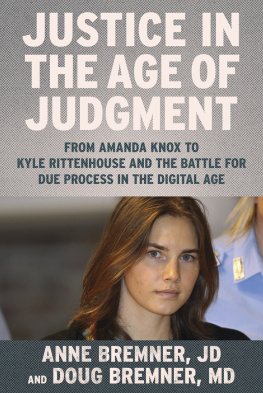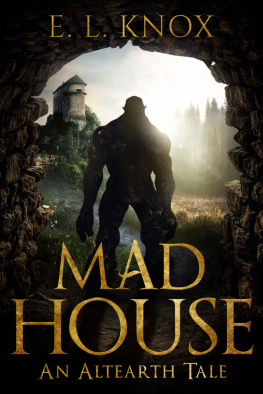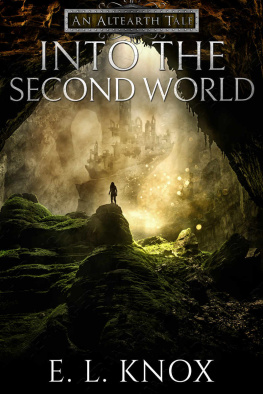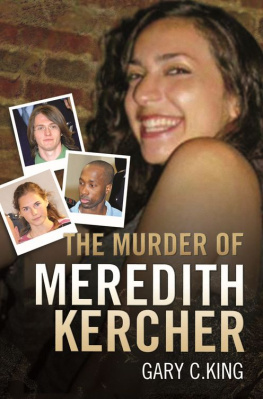


Copyright 2022 by Anne Bremner, JD, and Doug Bremner, MD
All rights reserved. No part of this book may be reproduced in any manner without the express written consent of the publisher, except in the case of brief excerpts in critical reviews or articles. All inquiries should be addressed to Skyhorse Publishing, 307 West 36th Street, 11th Floor, New York, NY 10018.
Skyhorse Publishing books may be purchased in bulk at special discounts for sales promotion, corporate gifts, fund-raising, or educational purposes. Special editions can also be created to specifications. For details, contact the Special Sales Department, Skyhorse Publishing, 307 West 36th Street, 11th Floor, New York, NY 10018 or .
Skyhorse and Skyhorse Publishing are registered trademarks of Skyhorse Publishing, Inc., a Delaware corporation.
Visit our website at www.skyhorsepublishing.com.
10 9 8 7 6 5 4 3 2 1
Library of Congress Cataloging-in-Publication Data is available on file.
Cover design by Brian Peterson
Print ISBN: 978-1-5107-5136-1
Ebook ISBN: 978-1-5107-5137-8
Printed in the United States of America
CONTENTS
PREFACE
My name is Anne Bremner. Im a lawyer from Seattle. In 2008, I was asked by an esteemed judge and his longtime colleague if I would be willing to help defend a Seattle college student accused of the brutal murder of her roommate while studying abroad in Italy.
Amanda Knox had become a household name, and her case drew a maelstrom of front page and television coverage around the world. But her friends and family insisted she was wrongly accused and innocent. When they told me the horrifying details, which involved a forced confession, a prejudiced and compromised investigation, and a seemingly irrational prosecutor hell-bent on convicting Amanda regardless of the facts, I more than willingly jumped in and agreed to help.
Little did I know it would take years and thousands of hours for our team in the United States and Italy to help win her exoneration. We battled a constant onslaught of lies and disinformation from an army of tabloid media that would breathlessly trumpet every false leak from the prosecution, not to mention the new world of social media where every mistruth would spread like wildfire.
It would become one of the most important cases of my life and test all my skills, which I had honed over decades of work as a prosecutor, defense attorney, and legal analyst. When the dust settled and I had a chance to reflect, I decided to write this book about the experience. I soon realized Amandas case ushered in a new era, in which the media and the public, through social media, have become a powerful force in the justice system, unduly influencing judicial outcomes. (It was already a factor even before social media. Just look at the big part media played in O. J. Simpsons acquittal and other high-profile trials Ive reported on as a network TV analyst over the years.)
With the advent of smartphones, everybody became a potential crime scene videographer, and the fact that footage can be loaded onto Facebook and Twitter and immediately go viral has turned the judicial world on its head. Although this type of footage can be a game changer and hold people accountable, it also holds the potential for harm, allowing viewers to make snap judgements and take things out of context before there has been a careful analysis of all of the facts. Thats why we have a judicial system, and not Facebook polls, to ultimately decide guilt or innocence.
My reflections on the effects of media and social media on Amandas case led me to go further: to some of the most high-profile cases Ive worked on and covered over the years. That, in turn, led me to take a deep dive into the media influence on the prosecution, and sometimes the outcome, of some of the most watched cases and legal proceedings of our era. As a result, I expanded the scope of the book.
Michael Jackson, the West Memphis Three, Harvey Weinstein and the rise of the #MeToo movement, the Duke Lacrosse rape case, Brett Kavanaughs Supreme Court nomination, the trials surrounding the deaths of George Floyd and Ahmaud Arbery, and the prosecution of Kyle Rittenhouse are just a few of the many cases Ive spent considerable time analyzing and pondering.
This book is an exploration of the evolution of our judicial system, as well as an autobiography of sorts, chronicling my unique upbringing, my legal education, and my decades-long career as an attorney and media analyst, all of which have influenced the person I am now.
I wrote this book with my brother, Doug Bremner, MD, a noted author and physician. His medical and psychiatric perspectives bring invaluable insight to the cases, and hes also a great writer.
I cant thank my cousin, Kristine Erickson, enough for her help on this book. Her expertise and incomparable skills as a writer and editor have been critical in the completion of this manuscript. I am forever indebted to her for her selfless contribution and dedication. Finally, I would like to thanks my amazing paralegal, Joan Stapleton, who passed away too soon ten years ago from melanoma.
TAKING THE CASE
It was that rare day in the Pacific Northwestsun and blue skies with just the right temperaturethe kind of day most Washingtonians savor, as they know it wont be long before the summer ends and its the start of the Seattle Rain Festival: October through May. It was July 2008, and I was at the Semiahmoo Resort, on a spit of land jutting out into the Strait of Georgiathe body of water separating Canada and the United States on the far western coast of both countriesnear Blaine, Washington. Semiahmoo, which appropriately means water all around or hole in the sky in the original North Straits Salish native language, has beautiful views of mountains in all directionsMount Baker, the Twin Sisters, and Canadian mountains rising up behind White Rock, British Columbia.
Semiahmoo is only a couple of stone throws away from Birch Bay, which my grandparents used to visit from their home in Lynden, Washington, and the Peace Arch at the border, where past generations of my family posed for photographs. This was the other part of western Washington, a remote area where the Nooksack and Skagit rivers periodically flooded the land, depositing sediments that created flat plains and fertile black soil perfect for farming. It was a magnet for immigrants from The Netherlands for which the landscape was a reminder of home. My family lived there for four generations. Semiahmoo was a respite from the pressures and push of Seattle, my day-to-day location, that also felt like coming home.
Presenting itself as the Capital of Cool, Seattle was in fact a city of contradictions. Haunted by the ghosts of the musicians Kurt Cobain and Jimi Hendrix, dead by suicide and overdose, respectively, Seattle may be the most progressive city in America. It tolerates open-air drug dealing and homeless encampments throughout the city, while it is also home of the richest man in the world, Jeff Bezos, founder, current executive chairman, and former chief executive officer of Amazon, the worlds largest and fastest growing retail organization. Bezos isnt actually from Seattle, though, although Bill Gates, founder of Microsoft and another one of the richest men in the world, is. The Seattle area was also the birthplace of Costco and Starbucks. The city was seemingly all about looking mellow and laid back, while maintaining a steady level of stress and drive on the inside. So, when I got a chance to make an exit to a place like Semiahmoo, even if it was doing the biz (i.e., the business, or working, as a lawyer in my case), I took it. And, hey, it was summertime.
Next page









